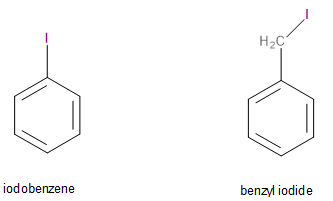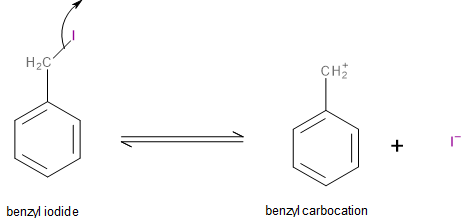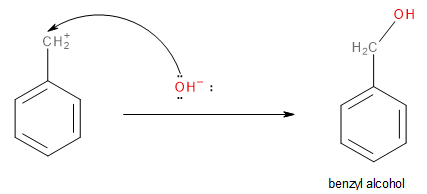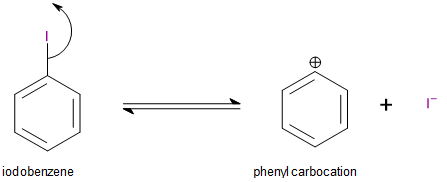
Bottles containing \[{C_6}{H_5}I\] and \[{C_6}{H_5}C{H_2}I\] lost their original labels. They are labelled A and B for testing. A and B were separately taken in a test tube and boiled with \[NaOH\] solution. The end solution in each tube was made acidic with dilute \[HN{O_3}\] and then some \[AgN{O_3}\] solution was added. Substance B gave a yellow precipitate. Which one of the following statements is true for this experiment?
A. A was \[{C_6}{H_5}I\]
B. A was \[{C_6}{H_5}C{H_2}I\]
C. B was \[{C_6}{H_5}I\]
D. Addition of \[HN{O_3}\]was unnecessary
Answer
222k+ views
Hint: Reacting iodobenzene (\[{C_6}{H_5}I\]) and benzyl iodide (\[{C_6}{H_5}C{H_2}I\]) with sodium hydroxide (\[NaOH\]) solution results in the nucleophilic substitution reaction (via the\[{S_N}1\]pathway) of only one of them. That will be the compound giving yellow precipitate with silver nitrate (\[AgN{O_3}\]).
Complete Step by Step Solution:
The given compounds are iodobenzene (\[{C_6}{H_5}I\]) and benzyl iodide (\[{C_6}{H_5}C{H_2}I\]). Their structures are given below:

Image: Structures of iodobenzene and benzyl iodide
On boiling benzyl iodide with sodium hydroxide solution, the iodine atom gets substituted by a hydroxyl group (\[ - OH\]). This is a nucleophilic substitution reaction that takes place via the\[{S_N}1\]mechanism.
The first step involves the iodine atom leaving the molecule as an iodide ion (\[{I^ - }\]) leaving behind a benzyl carbocation as shown below:

Image: Step 1
The second step involves the nucleophilic attack of the hydroxide ion (\[O{H^ - }\]) from sodium hydroxide.

Image: Step 2
The iodide ion liberated in step 1 reacts with silver nitrate (\[AgN{O_3}\]) solution to form a pale-yellow precipitate of silver iodide (\[AgI\]).
\[{I^ - }(aq) + AgN{O_3}(aq) \to AgI(s) + NO_3^ - (aq)\]
This process does not occur in the case of iodobenzene because the carbocation formed in this case is an unstable phenyl carbocation. It is unstable because the positive charge exists on a doubly bonded, \[s{p^2}\]hybridised carbon. Carbocations become stabilised when they are attached to groups that can donate an electron pair into their empty p-orbitals. In the case of phenyl carbocation, the\[s{p^2}\]nature of the positively charged carbon atom prevents it from donating an electron pair and stabilising the carbocation.

Image: Dissociation of iodobenzene to form a phenyl carbocation
On the other hand, the benzyl carbocation formed in the case of benzyl chloride is resonance stabilised. Thus, it can undergo the\[{S_N}1\]reaction with\[NaOH\].

Image: Resonating structures of benzyl carbocation
Thus, iodobenzene (\[{C_6}{H_5}I\]) is compound A and benzyl iodide (\[{C_6}{H_5}C{H_2}I\]) is compound B.
Thus, option A is correct.
Note: The answer to this question entirely hinges on the various factors that promote or inhibit\[{S_N}1\]reactions such as the stability of carbocations. Addition of dilute \[HN{O_3}\]also factors into this since\[HN{O_3}\]is protic and we know that protic environments promote\[{S_N}1\]reactions by helping make the carbocation intermediate stable.
Complete Step by Step Solution:
The given compounds are iodobenzene (\[{C_6}{H_5}I\]) and benzyl iodide (\[{C_6}{H_5}C{H_2}I\]). Their structures are given below:

Image: Structures of iodobenzene and benzyl iodide
On boiling benzyl iodide with sodium hydroxide solution, the iodine atom gets substituted by a hydroxyl group (\[ - OH\]). This is a nucleophilic substitution reaction that takes place via the\[{S_N}1\]mechanism.
The first step involves the iodine atom leaving the molecule as an iodide ion (\[{I^ - }\]) leaving behind a benzyl carbocation as shown below:

Image: Step 1
The second step involves the nucleophilic attack of the hydroxide ion (\[O{H^ - }\]) from sodium hydroxide.

Image: Step 2
The iodide ion liberated in step 1 reacts with silver nitrate (\[AgN{O_3}\]) solution to form a pale-yellow precipitate of silver iodide (\[AgI\]).
\[{I^ - }(aq) + AgN{O_3}(aq) \to AgI(s) + NO_3^ - (aq)\]
This process does not occur in the case of iodobenzene because the carbocation formed in this case is an unstable phenyl carbocation. It is unstable because the positive charge exists on a doubly bonded, \[s{p^2}\]hybridised carbon. Carbocations become stabilised when they are attached to groups that can donate an electron pair into their empty p-orbitals. In the case of phenyl carbocation, the\[s{p^2}\]nature of the positively charged carbon atom prevents it from donating an electron pair and stabilising the carbocation.

Image: Dissociation of iodobenzene to form a phenyl carbocation
On the other hand, the benzyl carbocation formed in the case of benzyl chloride is resonance stabilised. Thus, it can undergo the\[{S_N}1\]reaction with\[NaOH\].

Image: Resonating structures of benzyl carbocation
Thus, iodobenzene (\[{C_6}{H_5}I\]) is compound A and benzyl iodide (\[{C_6}{H_5}C{H_2}I\]) is compound B.
Thus, option A is correct.
Note: The answer to this question entirely hinges on the various factors that promote or inhibit\[{S_N}1\]reactions such as the stability of carbocations. Addition of dilute \[HN{O_3}\]also factors into this since\[HN{O_3}\]is protic and we know that protic environments promote\[{S_N}1\]reactions by helping make the carbocation intermediate stable.
Recently Updated Pages
Types of Solutions in Chemistry: Explained Simply

States of Matter Chapter For JEE Main Chemistry

Difference Between Alcohol and Phenol: Structure, Tests & Uses

Conduction Explained: Definition, Examples & Science for Students

Balancing of Redox Reactions - Important Concepts and Tips for JEE

Atomic Size - Important Concepts and Tips for JEE

Trending doubts
JEE Main 2026: Application Form Open, Exam Dates, Syllabus, Eligibility & Question Papers

Derivation of Equation of Trajectory Explained for Students

Hybridisation in Chemistry – Concept, Types & Applications

Understanding the Angle of Deviation in a Prism

How to Convert a Galvanometer into an Ammeter or Voltmeter

Degree of Dissociation: Meaning, Formula, Calculation & Uses

Other Pages
Solutions Class 12 Chemistry Chapter 1 CBSE Notes - 2025-26

NCERT Solutions For Class 12 Chemistry Chapter 1 Solutions - 2025-26

The D and F Block Elements Class 12 Chemistry Chapter 4 CBSE Notes - 2025-26

NCERT Solutions for Class 12 Chemistry Chapter Chapter 7 Alcohol Phenol and Ether

NCERT Solutions ForClass 12 Chemistry Chapter Chapter 8 Aldehydes Ketones And Carboxylic Acids

JEE Advanced Marks vs Ranks 2025: Understanding Category-wise Qualifying Marks and Previous Year Cut-offs




